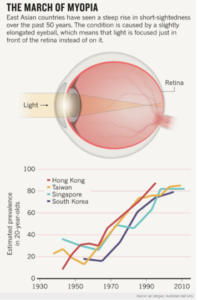The Myopia Boom
In this data-rich article the authors plot the path of myopia’s occurrence to its current epidemic levels, charting the various culprits blamed – from genetics, to book work and, from the most recent studies, to screen-time and reduced outdoor play. Here’s an excerpt from the article, with a full link following below.
“Researchers have consistently documented a strong association between measures of education and the prevalence of myopia. In the 1990s, for example, they found that teenage boys in Israel who attended schools known as Yeshivas (where they spent their days studying religious texts) had much higher rates of myopia than did students who spent less time at their books4. On a biological level, it seemed plausible that sustained close work could alter growth of the eyeball as it tries to accommodate the incoming light and focus close-up images squarely on the retina.
“Attractive though the idea was, it did not hold up. In the early 2000s, when researchers started to look at specific behaviours, such as books read per week or hours spent reading or using a computer, none seemed to be a major contributor to myopia risk5. But another factor did. In 2007, Donald Mutti and his colleagues at the Ohio State University College of Optometry in Columbus reported the results of a study that tracked more than 500 eight- and nine-year-olds in California who started out with healthy vision6. The team examined how the children spent their days, and “sort of as an afterthought at the time, we asked about sports and outdoorsy stuff”, says Mutti.
“It was a good thing they did. After five years, one in five of the children had developed myopia, and the only environmental factor that was strongly associated with risk was time spent outdoors6. “We thought it was an odd finding,” recalls Mutti, “but it just kept coming up as we did the analyses.” A year later, Rose and her colleagues arrived at much the same conclusion in Australia7. After studying more than 4,000 children at Sydney primary and secondary schools for three years, they found that children who spent less time outside were at greater risk of developing myopia.”
Here’s the full article in the March 2015 issue of Nature.


